Rust Family Foundation: Archaeology Grants Program
The 2018 Excavation Season at Ban Qala, Iraqi Kurdistan
Principal Investigator: Antonietta Catanzariti
Assistant Curator of Ancient Near East, Smithsonian Institution
Freer Gallery of Art and Arthur M. Sackler Gallery
Located in the Qara Dagh region of Iraqi Kurdistan (fig.1), Ban Qala is a multi-period site that was identified via a survey conducted by Iraqi archaeologists in the 1940’s.
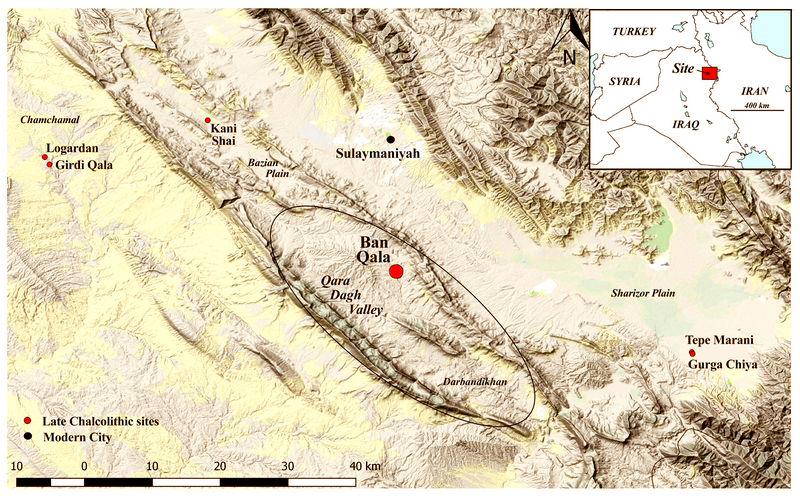 The site was revisited by the QDRAP team for a survey
project and was selected in 2017 for excavation. Our aim is to better
understand the material culture produced by the communities of the Zagros highlands and the cultural interconnections that existed between
highland and lowland settlements.
The site was revisited by the QDRAP team for a survey
project and was selected in 2017 for excavation. Our aim is to better
understand the material culture produced by the communities of the Zagros highlands and the cultural interconnections that existed between
highland and lowland settlements. Fig.1: Location of Ban Qala in the Qara Dagh region.
Since 2017, we have been able to improve our knowledge on this region of northern Mesopotamia, which, until now, has received little attention. The QDRAP excavation is, in fact, the first that has taken place at Ban Qala.
Previously, Qara Dagh was mainly known for the Darband-i-Gawra relief (end of third millennium beginning of second millennium BCE) and the Sasanian Paikuli remains. Thanks to the excavation being conducted at Ban Qala, a reconstruction of the settlement history of the region has begun.
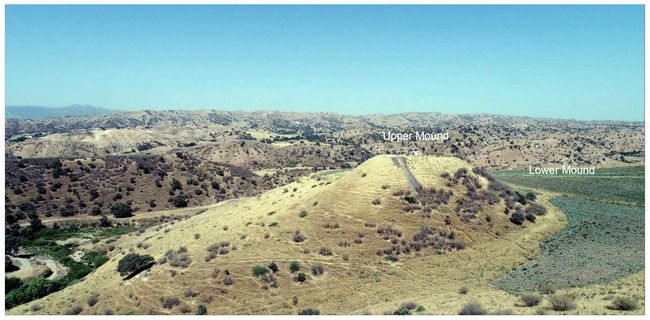
Fig.2: Aerial Image of Ban Qala.
.
Current Project (RFF-2018-69)
Goals:
The 2018 season took place in June-July 2018 and was the second campaign conducted at Ban Qala by the QDRAP team. Our main goals for the 2018 excavation season were:
1) Investigate the third millennium occupation levels of Ban Qala.
2) Verify the presence of an occupation level earlier than the Late Chalcolithic 2 period.
3) Collect data related to the material culture produced in the valley that can be compared with that of the lowland settlements.
4) Radioarbon dating analysis.
Methodology and Findings:
During the 2018 excavation season, the team focused on the upper mound and on the lower section of the southern slope of the mound (fig.2). A priority was to clarify our understanding of the settlement history of Ban Qala on the upper mound. Based on our 2017 season findings, the upper mound was occupied during the third millennium BCE, but the extent of such occupation and its relevance was unclear to us. To this end, we opened trenches N110-N120 and M110-M120 on the upper mound to expose a larger area of the third millennium levels (fig.3). In addition to the trenches that we opened on the upper mound, a fifth trench, N70, was opened along the southern slope of the mound to investigate the presence of older occupation levels at Ban Qala.
.
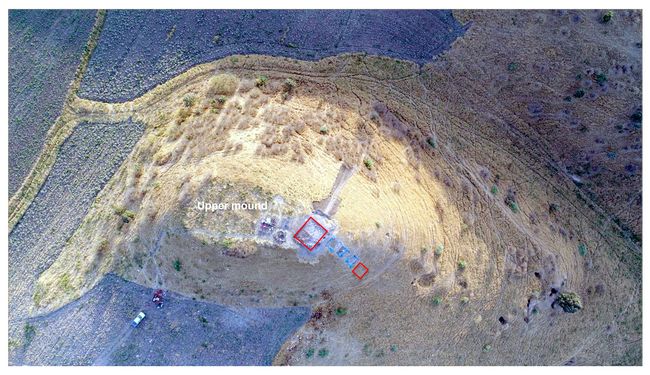
Fig.3: Aerial Image of Ban Qala upper mound and excavated areas (red)
Excavation and Findings of Trenches N120 and M120:
After the removal of 5 cm of the top soil layers from trenches N120, a stone wall with a south-west orientation was exposed. The mudbrick layers of this wall were entirely eroded but evidence of a door entrance was found. The function of the wall is still unclear. Just northwest of this feature was an installation where a small figurine along with a broken vessel was recovered. This type of figurine (fig.4) is generally found in the Anatolian region and is datable to the Early Bronze Age period (Atakuman 2017, 91 fig. 5e). Such a finding is an important outcome for the Qara Dagh project, as this figurine will
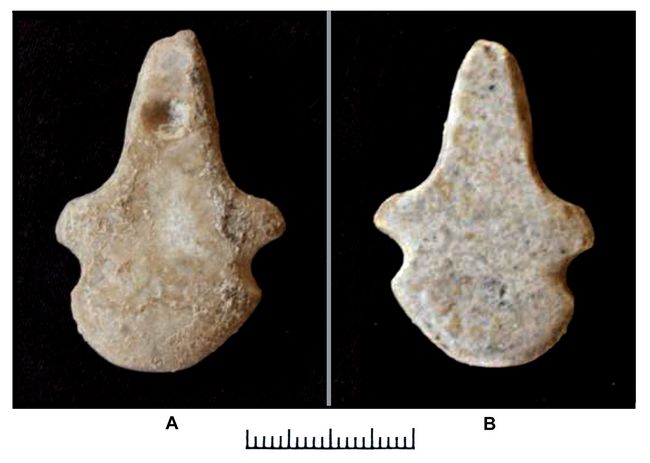 improve our understanding of the community living in this area and the
international connections that this region had with Anatolia. Similar
figurines are known from ritual or funerary contexts in Anatolia and
additional research is needed to understand their presence at Ban Qala
and within the northern Mesopotamia context.
improve our understanding of the community living in this area and the
international connections that this region had with Anatolia. Similar
figurines are known from ritual or funerary contexts in Anatolia and
additional research is needed to understand their presence at Ban Qala
and within the northern Mesopotamia context..
Fig.4: Figurine, a) front and b) back (locus 22 N120)
West of the wall and extending into trench M120 was a pottery waste area extending 8 meters long (south/w
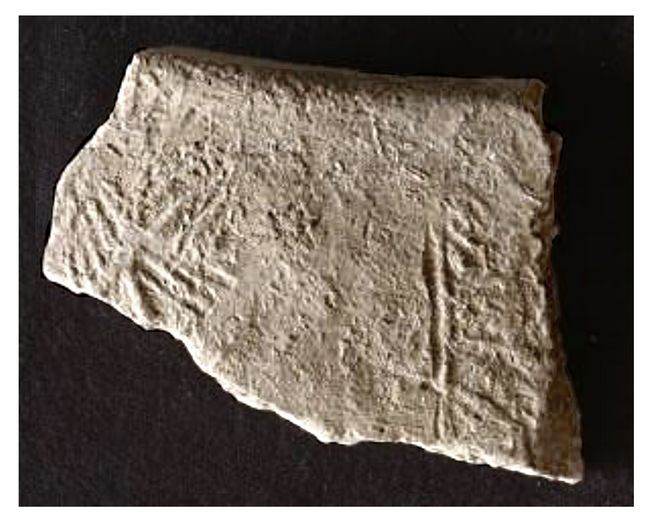 est orientation) and 50 cm wide. This particular
archaeological context can be interpreted as a pottery waste dump,
examples of which are typically found on sites where there is evidence
of pottery production. While removing the several layers of the pottery
waste, we recovered two seal impressions (figs.5-6).
est orientation) and 50 cm wide. This particular
archaeological context can be interpreted as a pottery waste dump,
examples of which are typically found on sites where there is evidence
of pottery production. While removing the several layers of the pottery
waste, we recovered two seal impressions (figs.5-6).Fig.5: Piedmont Style seal applied to an open mouth jar (M120 L. 17)
The first impression (fig.5), datable to the early third millennium BCE, is of the Piedmont style and was applied over the side of a wide mouth cooking jar. The second seal impression (fig.6) was located on the front of a lump of clay used to seal jars. The impression is datable to the Early Dynastic Period III (ca. 2600–2350 B.C.) and displays two scenes. The first scene is a banqueting scene composed of a sequence of individuals facing each other and drinking with a straw from a pot. Below the banqueting scene is a contest scene with animal figures. The back of the lump of clay shows the impression of the cloth used to cover the jar.

Fig.6: Seal Impression from the Early Dynastic Period (A), front; (B) cloth impression, back
The excavation of trenches N120 and M120 was significant as it provided us with some indications as to the activities that most probably took place on the upper mound. The pottery waste dump, with its large amount of pottery, indicates that some form of pottery production was carried out at the site. The location of the production site needs to be identified along with the structures (kilns) that come with such production. The pottery recovered is of invaluable importance as it has enabled us to begin the production of a typology of the third millennium pottery type of the Qara Dagh region. More specifically, some of the most common forms found were the string cut flat-concave bases with parallels available in northern Mesopotamia. These usually belong to small bowls and at Ban Qala can be mainly identified as small cups with a diameter of 3 cm. (fig.7). Also recovered was a jar with combed decoration (usually
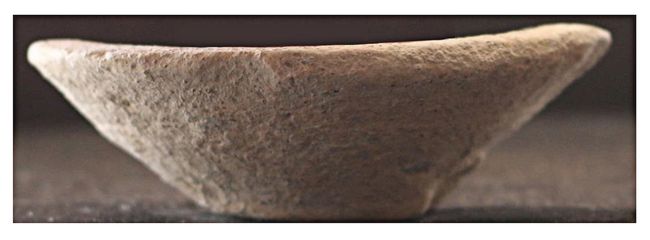 applied to medium-large jars), with parallels
well-documented throughout northern Mesopotamia.
applied to medium-large jars), with parallels
well-documented throughout northern Mesopotamia.Fig.7: Small cup from the pottery waste (H 2 cm x W 3 cm).
Excavation Trench M110
The excavation of trench M110 revealed another archaeological context of interest. Here were exposed 3 tannurs (70 cm x 70 cm circa) (fig.8), suggesting the use of this area for the production of bread. Only the bottom parts of the tannurs were identified. Based on C14 dating, these tannurs can be dated to the 14th century CE, but since new tannurs were often built over or near the location of old tannurs (Rova 2014), the original tannurs could be dated to an earlier period. The presence of a significant accumulation of ash deposits in the area surrounding the tannurs, which likely were removed from the tannurs (Rova 2014), tends to support this idea. The tannurs found at Ban Qala are not associated with an external structure but may have belonged to a house. In M110, the tannur found outside the wall might indicate that a tannur was built outside the house and possibly used for summer activities, as suggested by excavations at the site of Tell Bazi (Restelli and Mori 2014).
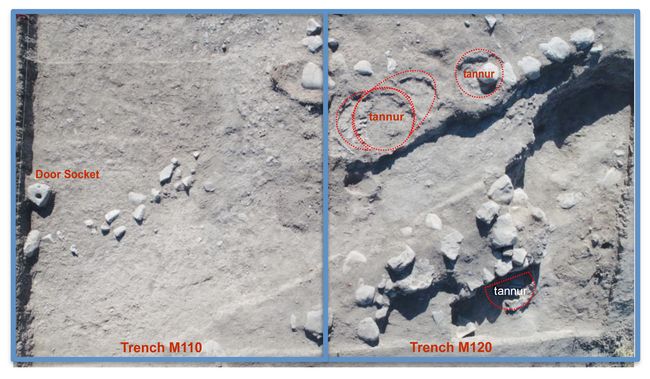
Fig.8: Aerial view of trenches M110- M120 showing sets of tannurs (ovens)
Unfortunately, the southern sector of trench M110 showed evidence of looting with modern pits cutting through the archaeological features. After clearing a large pit, we exposed a stone wall (3 layers) and west of the wall was a tannur containing an upside-down pedestal ceramic vessel.
Excavation of Trench N70
Towards the last days of excavation, after digging 50 cm deep on the northern sector of trench 70, we uncovered a large burial jar containing an adult human body (fig.9). The jar containing the human body can be dated to the Parthian period, based on the ceramic vessel type. The tradition of placing the dead along the slope of the mound is commonly found in the ancient Near East during the Parthian period
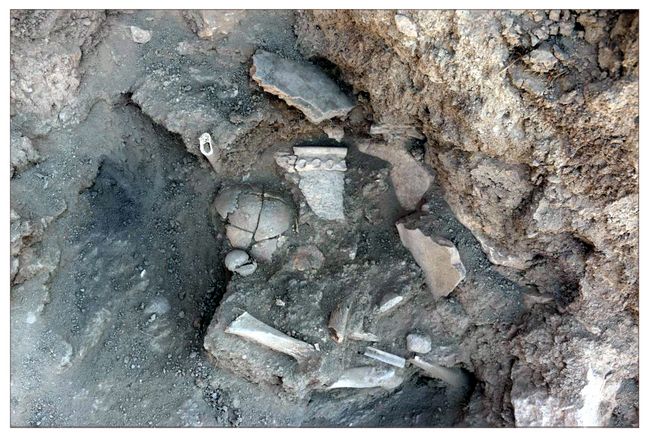 (e.g. Iran see Curtis et
al. 2000). This burial will improve our study of the funerary practices
that were taking place at Ban Qala and future excavation along the
slope will provide us with data that will improve our understanding of
such practice.
(e.g. Iran see Curtis et
al. 2000). This burial will improve our study of the funerary practices
that were taking place at Ban Qala and future excavation along the
slope will provide us with data that will improve our understanding of
such practice.Fig.9: Parthian burial jar with human body recovered in trench N70.
When we opened trench N70, our primary goal was to further investigate the presence of an occupation phase that could be dated prior to the Late Chalcolithic period, but the trench was heavily eroded, and the pottery recovered is consistent with the material recovered in 2017 in trench N80, datable to the Late Chalcolithic period 1-2. Other findings that we recovered in trench N70 are for example, several animal clay figurines and a spindle. In addition, of relevance was the presence of a considerable numbers of obsidian tools, among which were scrapers, awls, projectiles, points and drills.
Results from current project (RFF-2018-69)
The 2018 excavation season has greatly improved our understanding of the region’s settlement history and material culture. With the extension of the excavation area on the upper mound, we were able to better define the daily activities that were taking place at Ban Qala and when they were abandoned on the upper mound. We suggest that this mound was regularly occupied until the mid-third millennium BCE and the people using this sector of the mound moved or transferred their activities to the lower mound. In trenches N-M120, we exposed thousands of sherds with pottery slags found in a pottery waste dump. Such a context indicates that Ban Qala was engaged in some form of pottery production. Presumably, there was a kiln dedicated to the production of pottery. It is not possible to know yet where this installation was located; it will require more excavation work.
Directly above the pottery waste area were three tannurs that were exposed in trench M110 and are datable, according to the C14 analysis, to the 14 century CE, suggesting temporary activities were taking place on the mound in later periods. Along with the identification of such activities, we have also identified some architectural techniques in use during this time. Although a complete structure was not yet found, we exposed some walls that show the combined use of stone and mudbrick as a construction technique.
Administrative work was carried out, as already suggested by the 2017 excavation data. This summer, we recovered two seal impressions (figs.5,6), which further strengthen the case for the adoption of an administrative system at the site. The seal impressions are datable to the mid-third millennium and the style visible on these seals recalls some in use in southern Mesopotamia.
Of particular interest is the discovery of a figurine found in trench N120 (fig.4). Such figurines are mainly known in Anatolia and are usually datable to the Early Bronze Age. This is the first stone figurine that we have recovered. Its finding is very important because it will allow us to put forth suggestions on the spread of ritual and/or artistic practices in northern Mesopotamia. This season also gave us additional data to better grasp the settlement’s occupation history. Although trench N70, located near the bottom of the slope, was heavily eroded, it allowed us to confirm that the site had a long occupation phase during the Late Chalcolithic period and only future excavation will allows to verify the relevance of this period at this site and activities being perfomed.
Finally, our information on burial practices has been further enhanced by the recovery of a Parthian period jar along the slope of the mound (Fig.9). The practice of placing the deceased along the slope has been documented in Iran during the Parthian period. At Ban Qala, a child burial from the Late Chalcolithic period was also documented in 2017 along the slope, suggesting that this practice continued over time up to the Parthian period.
The research being conducted at Ban Qala has helped us to begin the process of filling the gaps open on the settlement history of northern Mesopotamia. This region, with its diverse geographic conformation, does not receive much attention, yet it could greatly improve our understanding of ancient communities in such areas, and in particular, on how the landscape may have influenced their development in comparison to the settlements on the plains.
References:
Atakuman, Ç. 2017. “Figurines of the Anatolian Early Bronze Age: The assemblage from Koçumbeli-Ankara.” Anatolian Studies 67: 85–108.
Balossi, Restelli F. and Mori, L. 2014. “Bread, baking moulds and related cooking techniques in the Ancient Near East.” Food and History 12:3, 39-55.
Curtis, Vesta Sarkosh, St. John Simpson, Mir-Abedin Kaboli, Kamyar Abdi, Gennadi Ivanov, Tanabe Katsumi, and Barbara Kaim. 2000. "Archaeological News from Iran and Central Asia: Third Report". Iran. 38: 151.
Rova, E. 2014. “Tannurs, Tannur Concentrations and Centralised Bread Production at Tell Beydar and Elsewhere: An Overview.” In Paleonutrition and Food Practices in the Ancient Near East: Towards a Multidisciplinary Approach, ed. L. Milano, 121–170. Padua, S.A.R.G.O.N. Editrice e Libreria.
Recent Foundation grants: general Archaeology Grants Program w/map
Copyright © 2019 Rust Family Foundation